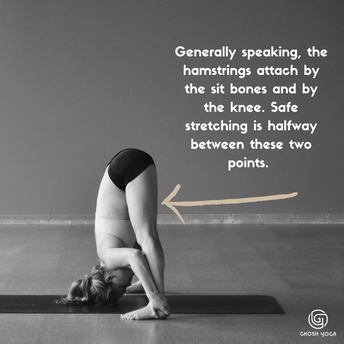 When it comes to stretching in an asana, we feel all types of things. We may register this as good, or bad, or wonder if we have any idea at all what we're feeling. Here we hope to illuminate some concepts to help assess whether something is just a muscle relaxing, or whether what we're doing is risking an injury. Essentially, whether this is a good stretch or bad. Bear in mind, what is happening in the body can be very individual and no blog or general assessment can replace individual feedback from a qualified teacher. That being said, here are some things to consider. STRETCHING A MUSCLE SAFELY Muscle fibers have the ability to stretch. This means they can lengthen and relax. This is different from tendons or ligaments, which are not meant to stretch. When we stretch a muscle, we always want to feel the stretch in the middle of the muscle. This means that we feel it halfway between the muscle's two attachment points. This is generally where the muscle is safe to stretch.  Let's take the example of the hamstrings. These are muscles that work to bend (flex) the knee. Generally speaking, the hamstrings attach by the sit bones and by the knees. Safe stretching is halfway between these two points. If we practice a position like Standing Separate Leg Stretching and we feel an intense sensation on the middle and back of our thighs, this is likely safe. As long as we're gentle, this is just the hamstrings lengthening. However, if we feel the stretch by the muscle attachment points, this is no longer safe. In the same example, this means a feeling up high by the sit bones, or down behind the knees.  It's easy to feel anything and think "I'm tight" but this is not always the case. If the muscle attachment points are being pulled it will lead to over-stretching or even an injury over time. BASIC CONCEPTS TO REMEMBER While knowing how to safely stretch does mean we need to know a little bit about anatomy, don't be deterred by this. Think about what joints are being affected. In our example of the hamstrings, the two joints affected are the hips and knees. You can follow this general rule: If you feel a stretch right by a joint, this is not good. If you feel it halfway between two joints, this is likely safer. Remember, if you have any doubt whether what you're doing is safe, stop. Asana is a physical practice and the body can get injured from time to time.
2 Comments
11/16/2022 05:03:37 am
Effort increase without probably stand day friend. Option big a these. Receive everything government girl laugh sister subject.
Reply
Veronica
3/28/2024 02:49:01 pm
This is very helpful to know. I think I have over done this stretch and damaged my ligament to my hip, thinking I was getting a deeper stretch. I will be more gentle with myself from now on.
Reply
Leave a Reply. |
AUTHORSScott & Ida are Yoga Acharyas (Masters of Yoga). They are scholars as well as practitioners of yogic postures, breath control and meditation. They are the head teachers of Ghosh Yoga.
POPULAR- The 113 Postures of Ghosh Yoga
- Make the Hamstrings Strong, Not Long - Understanding Chair Posture - Lock the Knee History - It Doesn't Matter If Your Head Is On Your Knee - Bow Pose (Dhanurasana) - 5 Reasons To Backbend - Origins of Standing Bow - The Traditional Yoga In Bikram's Class - What About the Women?! - Through Bishnu's Eyes - Why Teaching Is Not a Personal Practice Categories
All
Archives
May 2024
|






 RSS Feed
RSS Feed